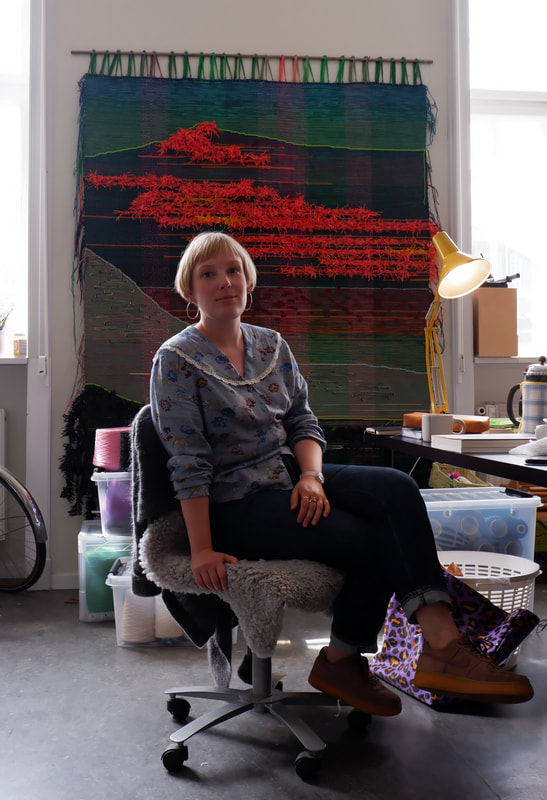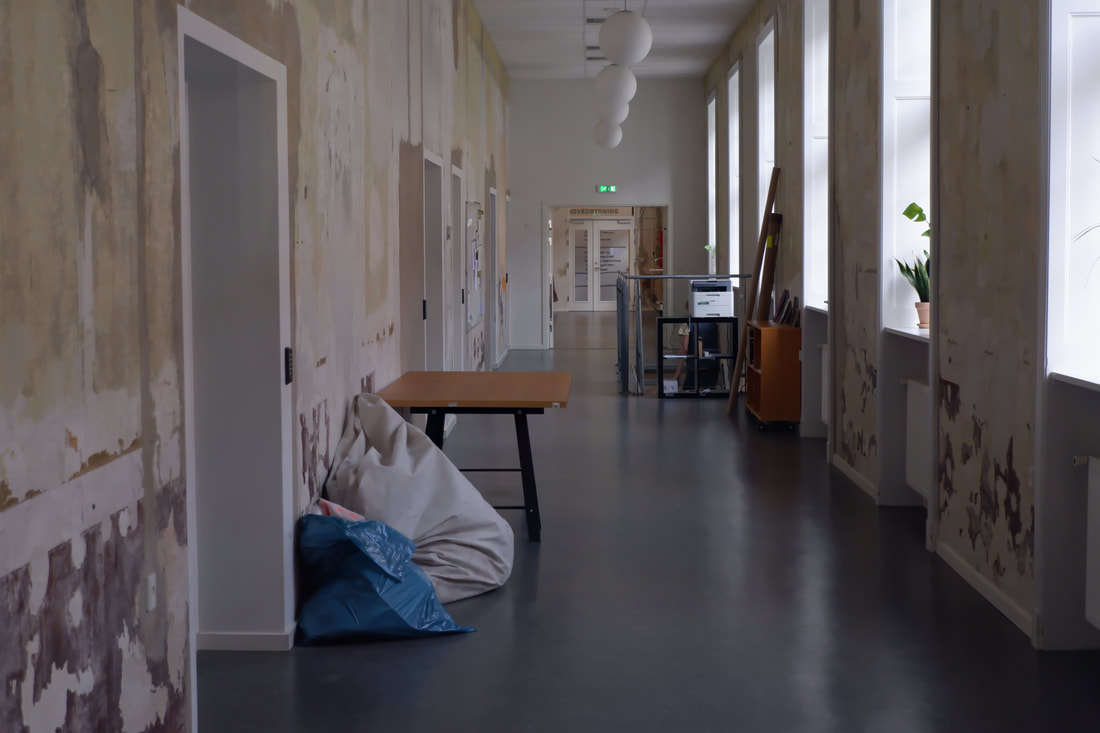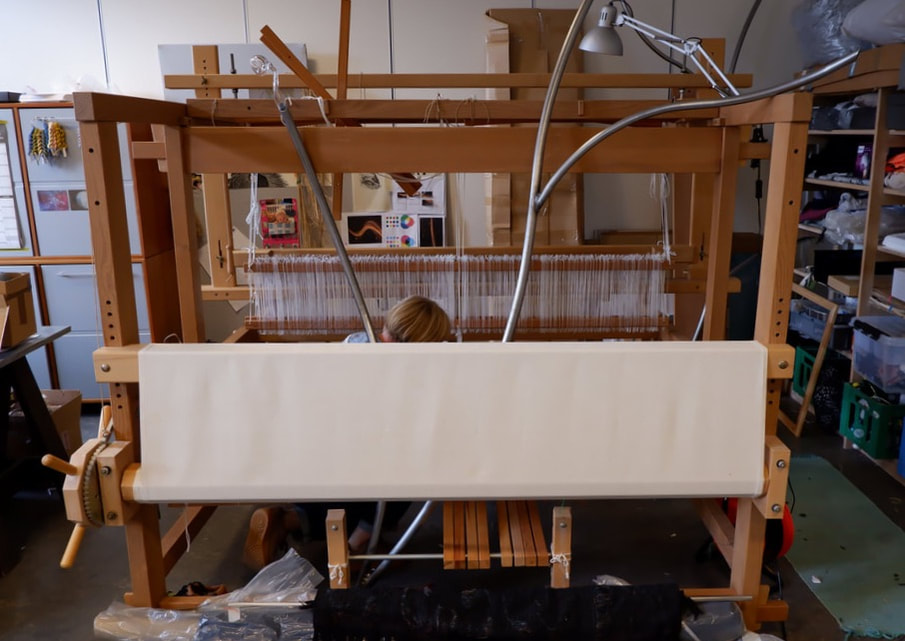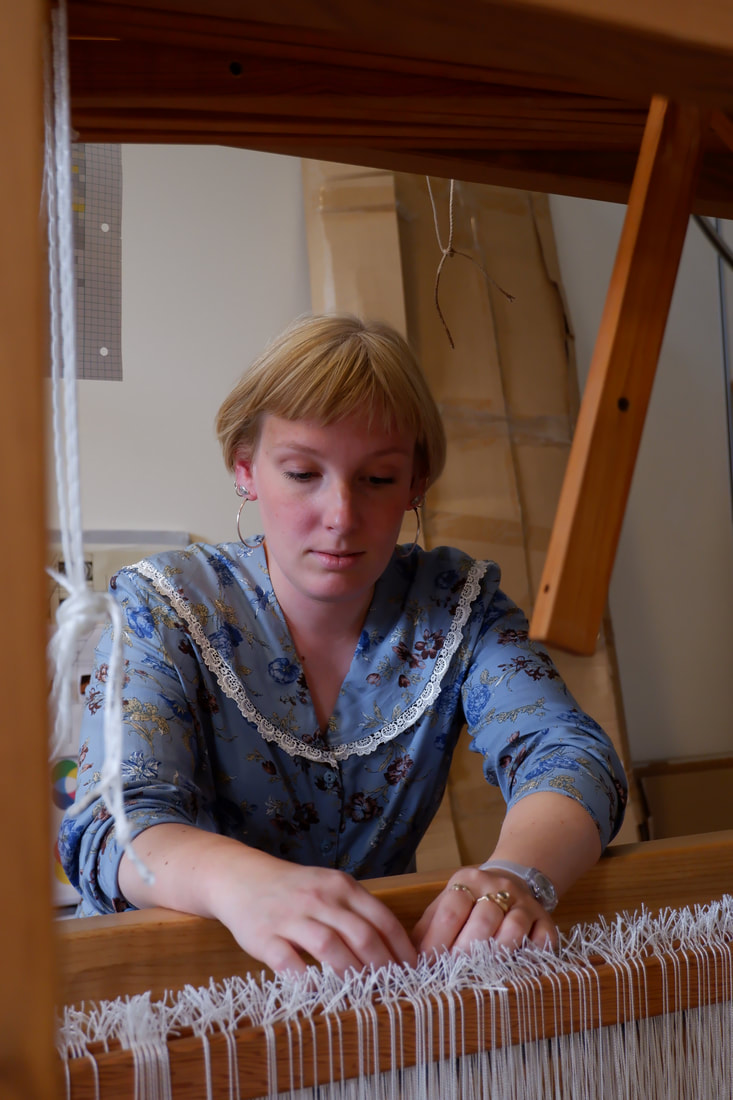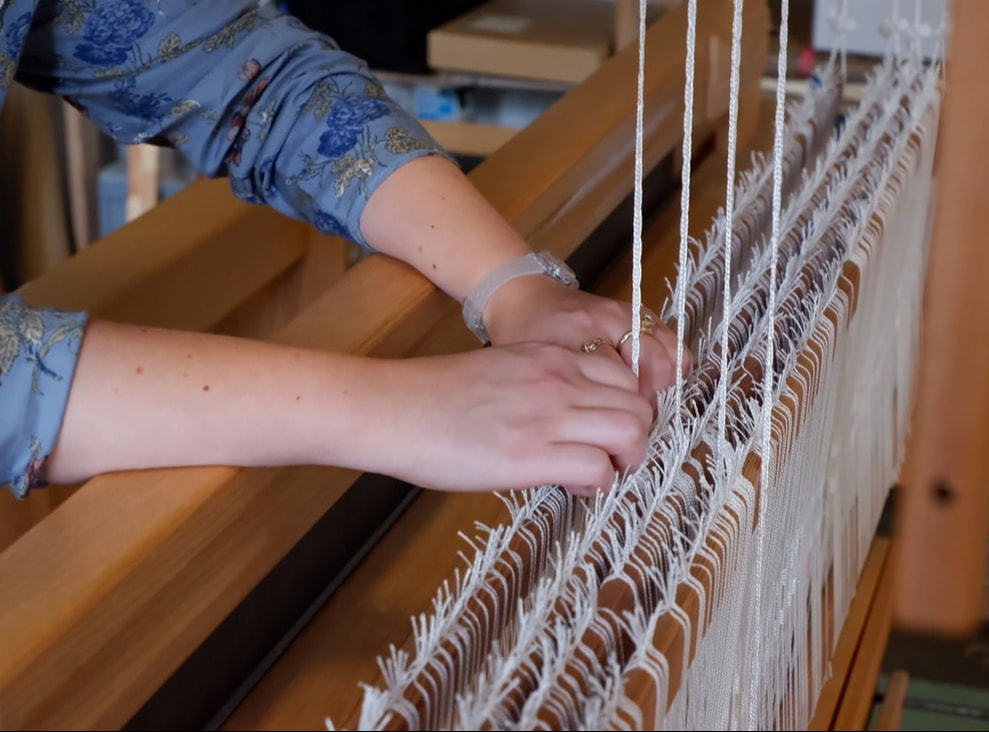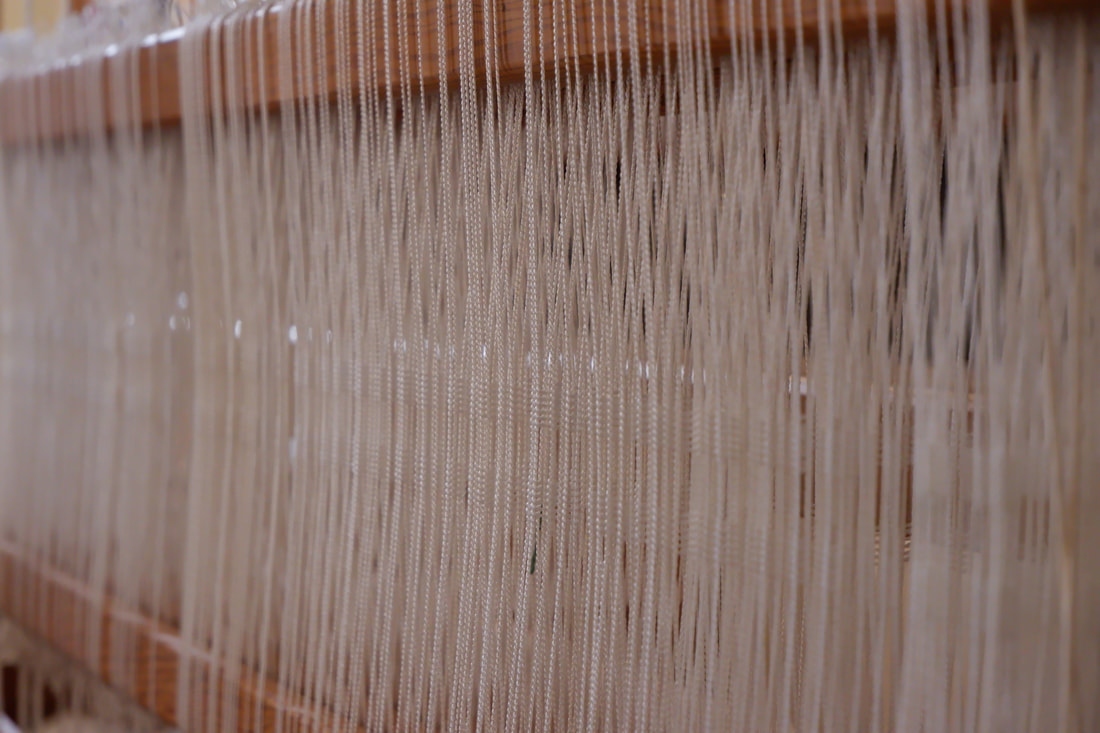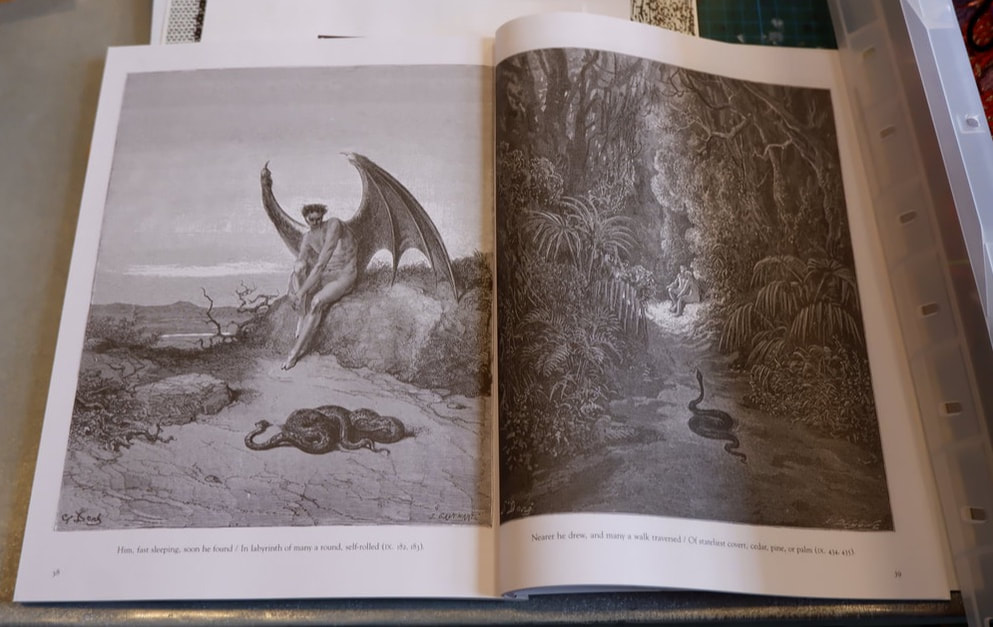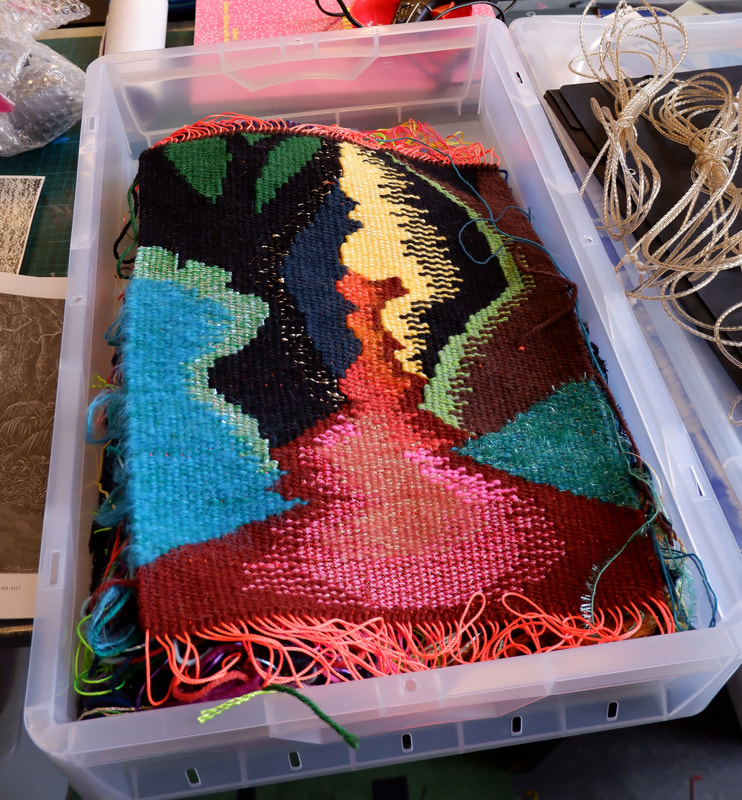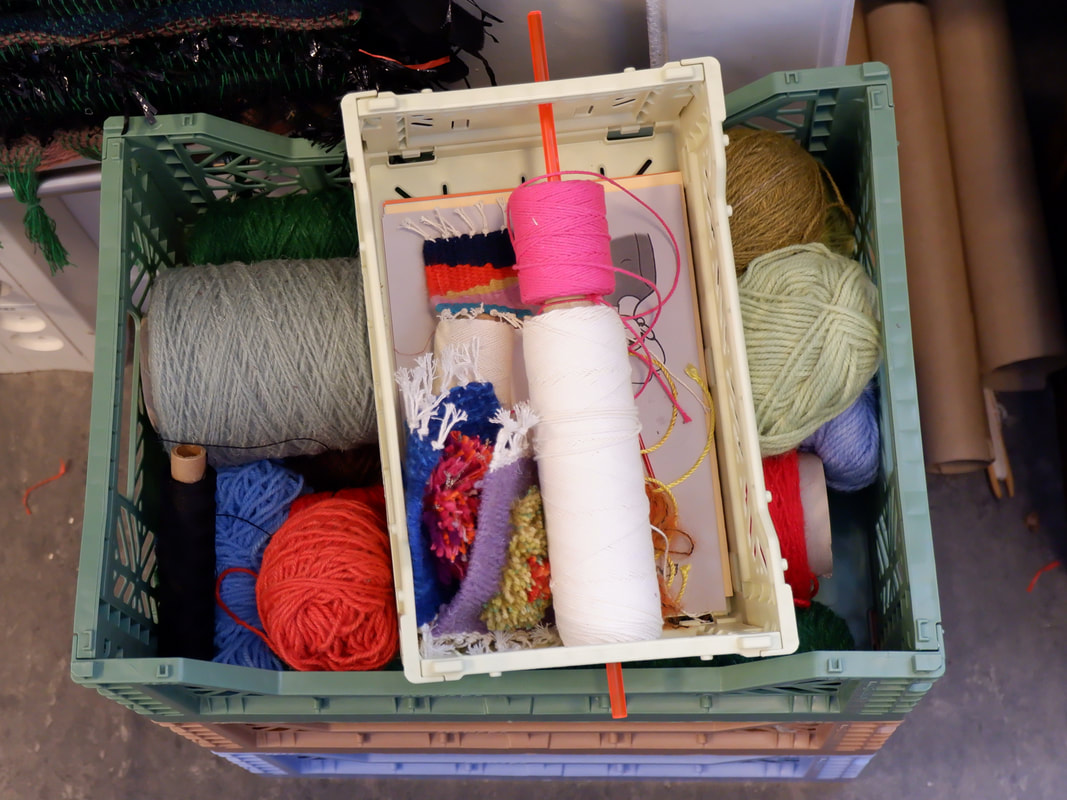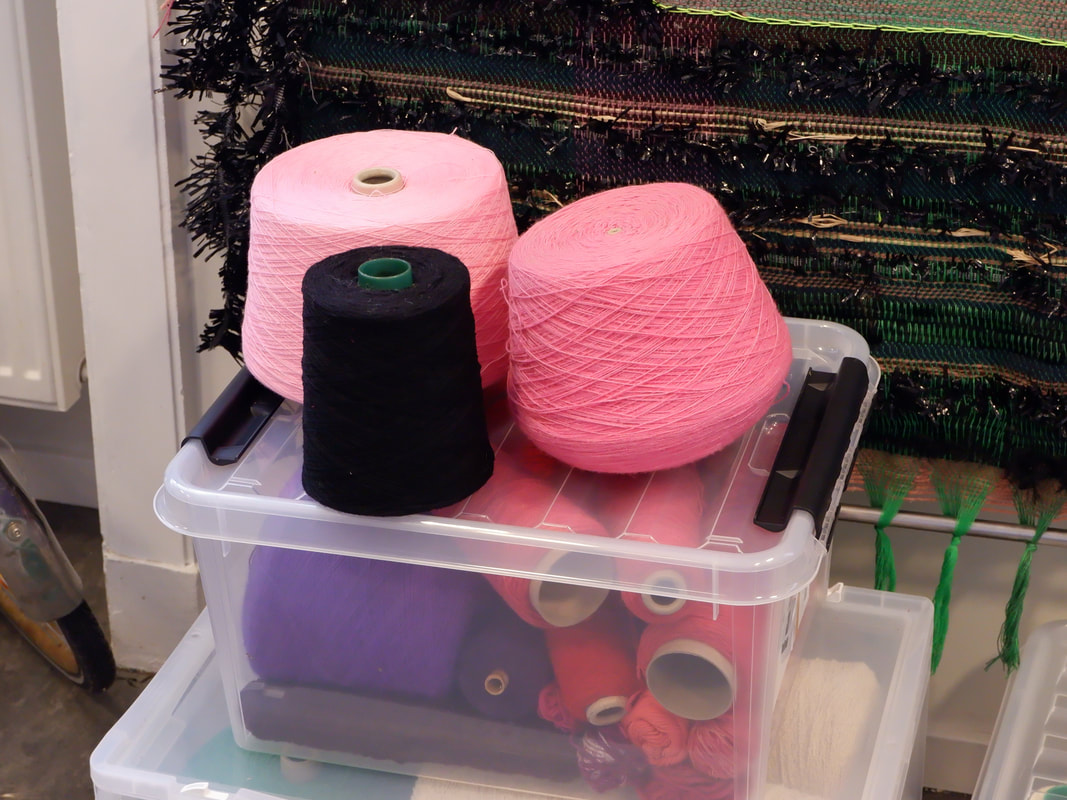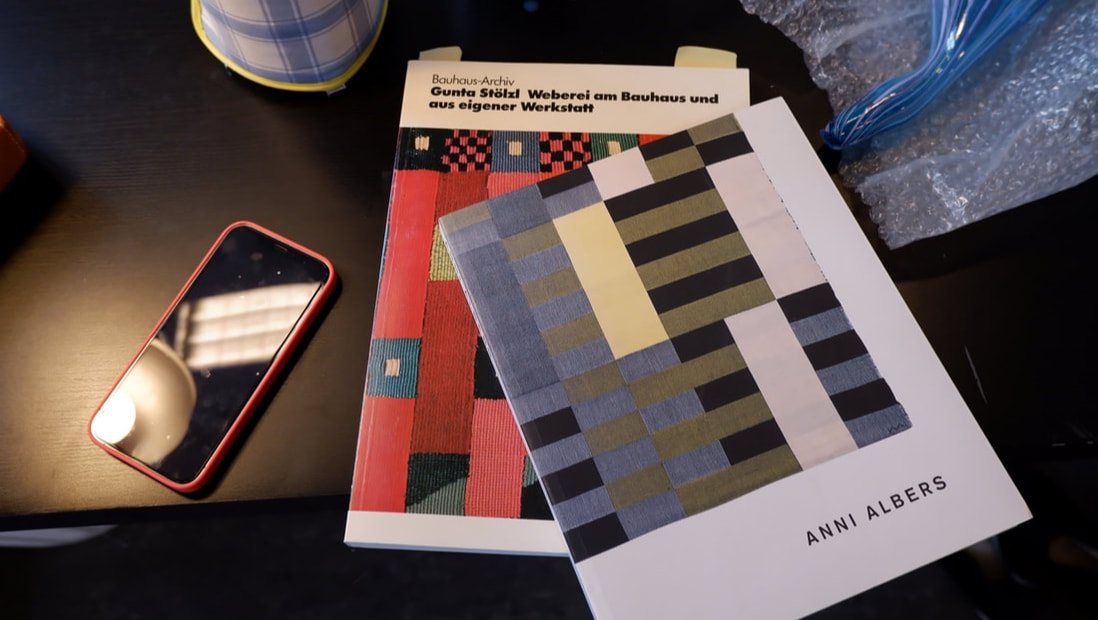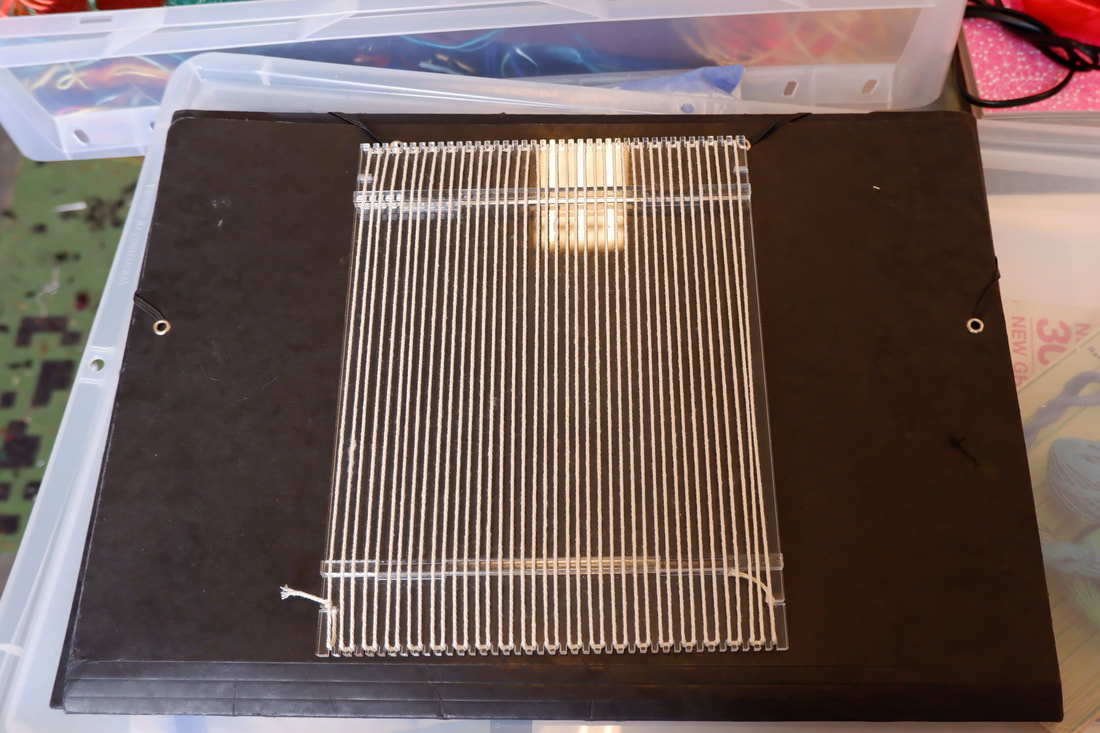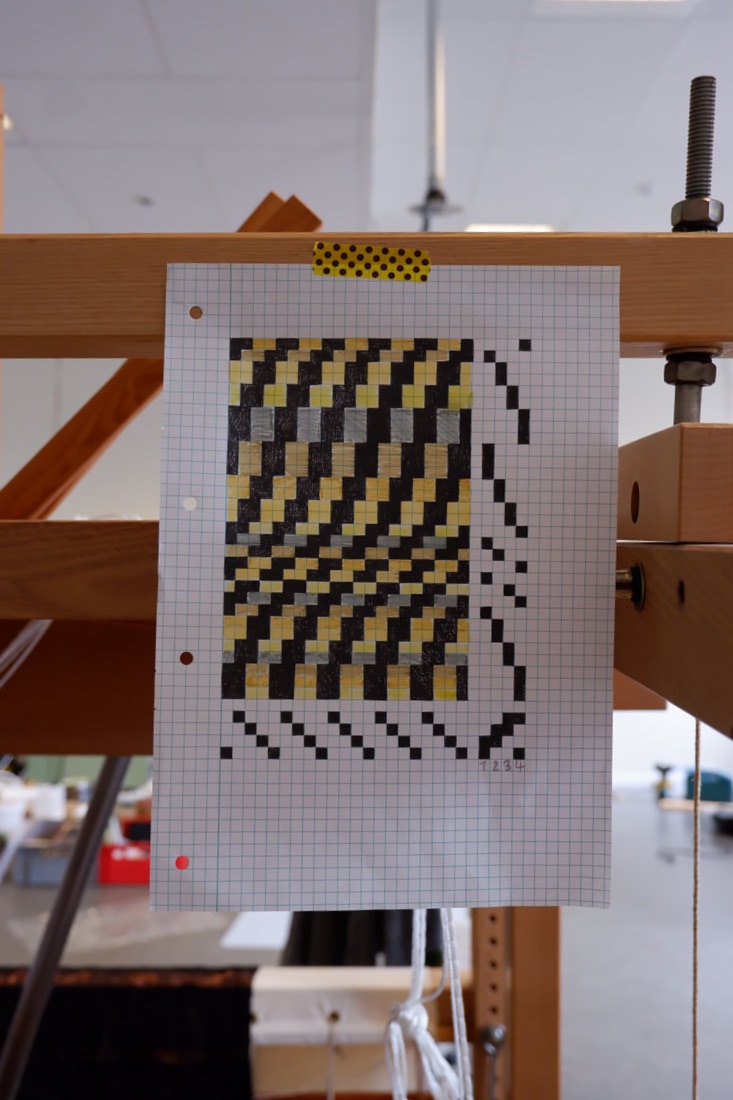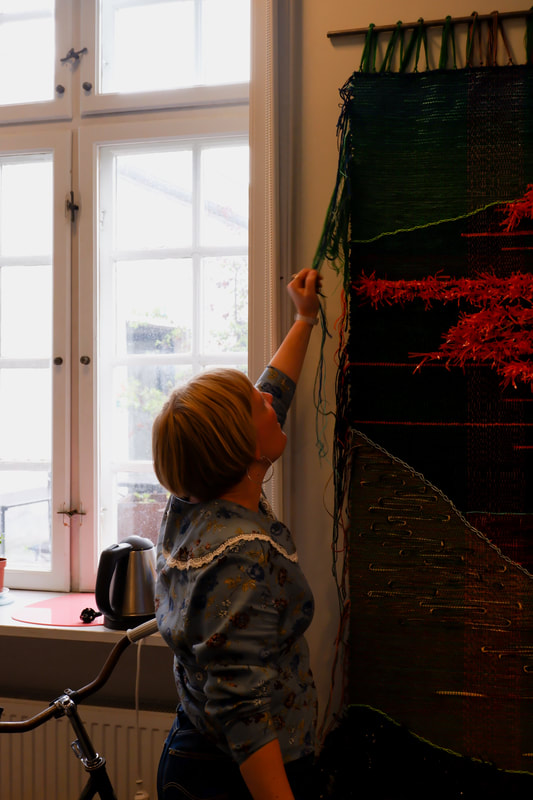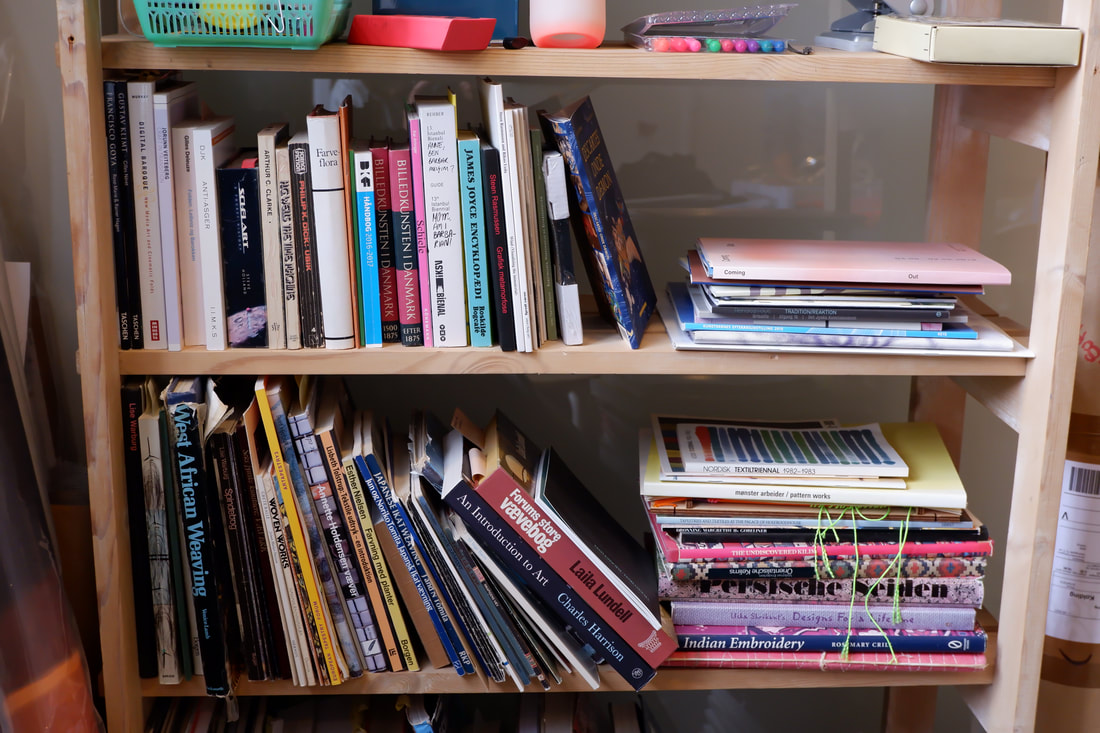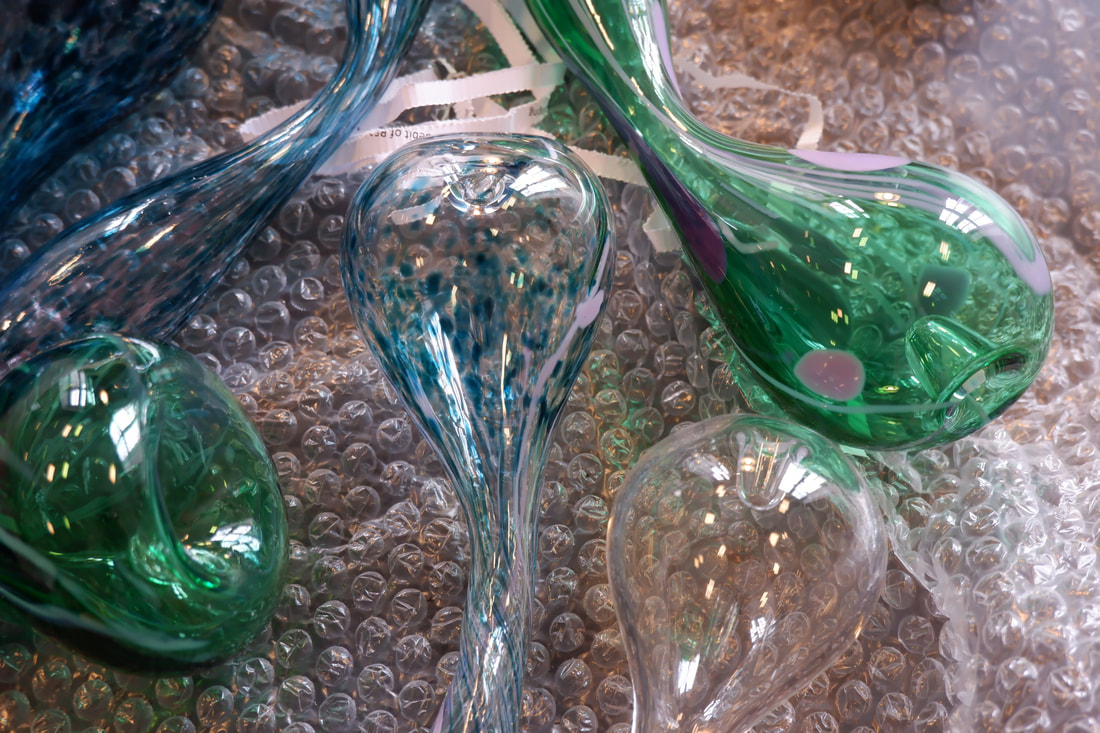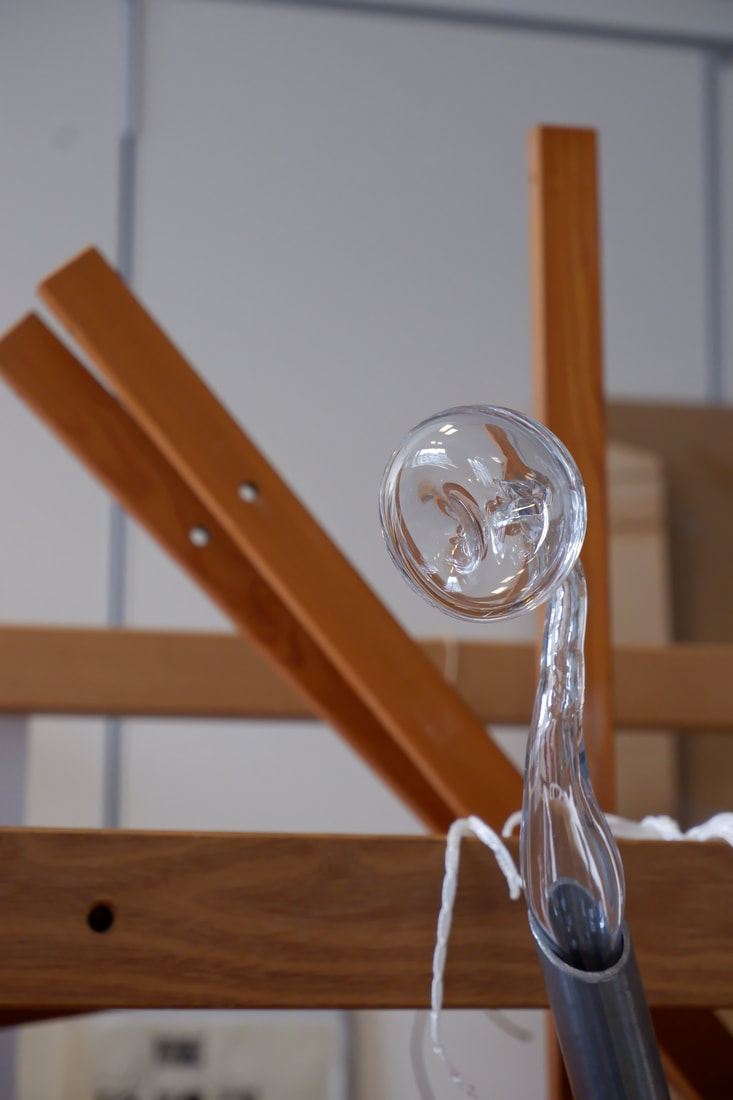Visiting Visual Artist Anne-Sofie Overgaard
in her Studio at Godsbanen
Text and photography by Nora Benz | September 2021
Weaving is one of the oldest techniques of producing textile fabrics. By crossing at least two thread systems, the weft and the warp, a multitude of woven pieces, from carpets to tapestries can be produced. Ever since discovering the craft, visual artist Anne-Sofie Overgaard works with the powerful medium of loom and yarn to create unique pieces of art. Shortly before moving out of Aarhus, Articulate paid the Danish artist a visit in her studio in the studio community Corporum at Godsbanen.
How did you first get in touch with weaving and how did you learn it?
- It was during my second year of studying at Jutland Art Academy. In my first year I started doing some embroideries and from there it naturally developed that I wanted to get into weaving. At that point I didn’t know anything about the technique yet. But I came in touch with handicraft textiles very early as my mother was really good with her hands - she was always sewing, embroidering, drawing or painting. As I grew up like that, it was natural for me to start working with textiles. When you are standing in front of a tapestry or a woven image you get this really special feeling, at least I do. Because they are so heavy, and they convey a lot of time and history - I really think that weaving is a powerful medium.
At first I just started with small weavings to learn the craft. One day I called my mom and said ‘Do you know anything about weaving?’ And she replied ‘Oh yes, I did something like this in the 70s, when I was young. Maybe I have an old book.’ YouTube and similar platforms also taught me a lot as none of my teachers knew anything about weaving. In my fourth year of studying, I went to Bergen in Norway for an exchange year at the Bergen Academy of Art and Design (KHiB). They have a really nice department of weaving which is part of the department of fine arts. This is very different from Denmark where, if you want to work with weaving, you have to study textiles at a design school. But I was not interested in that. When I was in Bergen I really nerded out and learned a lot. It was there where I got into digital weaving as that was what they were focussing on. Probably because digital weaving was invented by a woman in Norway. In addition to digital weaving I learned everything else, like for example setting up a loom. But there is still a lot of learning by doing as there are so many different types of techniques and looms.
Do you have a favorite part in the weaving process? Or anything you really don’t like about it?
- In general I like the whole process. I also like setting up the loom. I think that there is something empowering about it, at least that is what I feel when I set up my loom. But to be honest, it is also really hard with all these threads. I also love to do the warping. And I actually like when I have to thread all these strands. You have to thread each of them.
That is a lot of work isn’t it?
- It is a lot of work, indeed. But it has a system. And you just have to accept it and sometimes it is really nice. I also like to listen to podcasts or audiobooks while working on that. But there is something meditative about it, too. And it is great that you can see how far you have come and how much more you need to do. But of course it is also very satisfying when I can finally start weaving.
- It is a lot of work, indeed. But it has a system. And you just have to accept it and sometimes it is really nice. I also like to listen to podcasts or audiobooks while working on that. But there is something meditative about it, too. And it is great that you can see how far you have come and how much more you need to do. But of course it is also very satisfying when I can finally start weaving.
How do you start a new piece of work?
- Mostly I start with an idea in my head of what I want to do. Once you are working on the loom, you can’t go back; you can’t really fix anything. You have to nail it. So I often have a good idea or concept of what I want to do. I always have my notebooks with me and I also make sketches of weavings that I plan to do. Mostly to get the colors right. I have been doing a lot of my landscape weavings based on Gustav Doré’s illustrations for John Miltons “Paradise Lost”. However, I didn’t want to have people, animals or angels in it because I think it is a binary, outdated depiction of good and evil, male and female. So I decided to make synthetic weavings inspired by the illustrations. If you compare my weavings and the original illustrations you see that they are totally different in style. The illustrations are black and white, my weavings are in color. Before starting on the loom I decided which colors I wanted to use, but figuring out what kind of yarn I wanted happened during the process.
And how do you feel about starting a new piece of work?
- I like it but I need some kind of goal. I want to be able to show it and I also need to be sure that other people see it. Then I get excited and want to work on the loom. Often that’s when I have a project or an exhibition. I mean, of course I make art because I like to create and don’t know what else to do, but it makes more sense when someone else sees it. Then the art piece lives for real.
How do you usually choose your fabric? Where do you get the fabrics from?
- Over the years I have collected quite a lot of yarn. I also got some from my mother and grandmother; others I just bought. Whenever I see yarn that I like, I buy it. Sometimes I also contact carpet factories because usually they have a lot of leftover yarn. That's one way to get a lot of fabric for free. For me it doesn’t have to be wool. The texture of the fabric is much more important to me. I think that this is also a reason why we as people like weaving art, because we immediately feel connected to it as textiles are something we are used to having around us. And it reflects warmth.
- Over the years I have collected quite a lot of yarn. I also got some from my mother and grandmother; others I just bought. Whenever I see yarn that I like, I buy it. Sometimes I also contact carpet factories because usually they have a lot of leftover yarn. That's one way to get a lot of fabric for free. For me it doesn’t have to be wool. The texture of the fabric is much more important to me. I think that this is also a reason why we as people like weaving art, because we immediately feel connected to it as textiles are something we are used to having around us. And it reflects warmth.
What other disciplines influence your work?
- When I started weaving I also learned about its history. And then of course I got interested in Bauhaus. Especially the empowerment of the female artists at the Bauhaus. Weavers, like Gunta Stölzl or Anni Albers are the godmothers of every person who wants to weave.
Weaving and the Bauhaus also have a very special relation as most women were not allowed to pursuit other paths like for example architecture.
- Yes, it was only in the last decade that what they did has been acknowledged as art. Back then, weaving and the weaving workshop were only seen as craftsmanship or design.
I am also inspired by outer space, and I am always looking at NASA pages, using a lot of their images as inspiration. That is just an ongoing thing. And now there are all these landscape images from Mars which I also collect and use. In my art I work a lot with contrast. For instance I get inspired by the Baroque, especially by old Baroque paintings and buildings and their way of using contrast in colours as well as the play with light and darkness.
- Yes, it was only in the last decade that what they did has been acknowledged as art. Back then, weaving and the weaving workshop were only seen as craftsmanship or design.
I am also inspired by outer space, and I am always looking at NASA pages, using a lot of their images as inspiration. That is just an ongoing thing. And now there are all these landscape images from Mars which I also collect and use. In my art I work a lot with contrast. For instance I get inspired by the Baroque, especially by old Baroque paintings and buildings and their way of using contrast in colours as well as the play with light and darkness.
You also did a lot of work which is about time and the passing of time. Do you know why this topic interests you?
- When I look back at my art practice, time has always been an interest and focus of mine. I don’t know why. Maybe it is just because it's one of the big questions in life. I have been working a lot with Sci-Fi and the way the linear idea of time gets blurred. I have also worked with historical stuff which I put into a new, present setting. Weaving itself is a process grounded in time as it takes a lot of time. The topic of time is imprinted into woven works because when people see a weaving they always ask about the amount of time I put into it; they immediately think it takes a lot of time. And of course it takes its time. Preparing my big loom for example takes about a week.
You spent some time in Berlin and Spain. Did your work change because your surrounding changed?
- I was in Spain, at CCA Andratx on Mallorca, for only a month, on a residency. I actually think that I haven’t been moving around that much but I have been quite steady here in Aarhus. I like going on residencies but it has become harder since I became a mother. So that really changed everything. But before having my child I was on a residency in Berlin, which was really nice. A lot of artists, when they graduate, move to Copenhagen or other big cities. But I didn’t do that, I stayed here. In that way it is exciting to go on residencies.
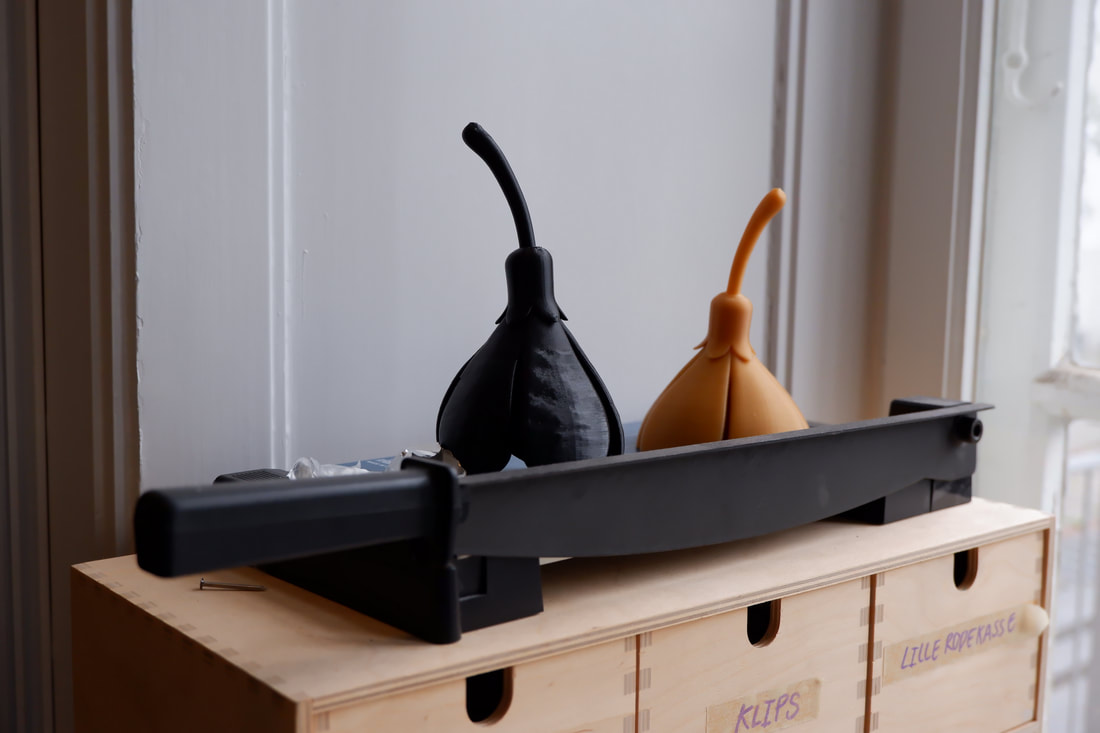 3D printed flowers for The Passing of the Present, and the Preservation of the Past which was exhibited at Horse & Pony in Berlin in 2019
3D printed flowers for The Passing of the Present, and the Preservation of the Past which was exhibited at Horse & Pony in Berlin in 2019
How did you like it here at Godsbanen? What was it like to work in this place where a lot of different people and different disciplines and also a lot of visitors are?
- Well, the visitors don’t come in here. That’s very important. I think it is nice to be at Godsbanen because the facilities are good. The open workshops here are also quite cool. When you visit them often, people get to know you. We artists don’t have any special agreements but follow the same terms and conditions as anyone else. That is obviously fair, but it can sometimes be a bit stressful, especially when there is a deadline you have to meet. But in general I liked it here. Although I would not do any exhibitions here anymore. In the public parts of Godsbanen there is a separate space for music and there is a separate space for theater, but there is no space dedicated to art. Apparently, the idea is that art can just be shown over the coffee tables. But I think, at least for professional artists, that’s not how it works. The art pieces are very fixed on the walls here. I mean, it is nice to show art to people that are not necessarily art educated. But unfortunately a lot of people don’t always respect the art pieces.
Do you have a favorite time of the day to work in your studio?
- I am mostly in my studio during the daytime. Until I have to pick up my son from kindergarten. I am not here everyday, but I always like being here and when I step into my studio I feel calm. If it was possible I would be in my studio every day.
- I am mostly in my studio during the daytime. Until I have to pick up my son from kindergarten. I am not here everyday, but I always like being here and when I step into my studio I feel calm. If it was possible I would be in my studio every day.
Do you have a favorite corner, thing or part in your studio?
- I would say my loom. It’s my baby. But I also love my books. I got a lot of weaving books from the Jutland Art Academy when I graduated. Until the 1990s they had a weaving department which is why they had a lot of textile and weaving books in their library. My teacher once came to me and said that they found two boxes of books in the basement and they thought that I might want them. So I inherited their books. Also, when I hear about weavers, I always look and see if I have a book about them. So it is often in my books where I find new inspiration and knowledge about weaving.
- I would say my loom. It’s my baby. But I also love my books. I got a lot of weaving books from the Jutland Art Academy when I graduated. Until the 1990s they had a weaving department which is why they had a lot of textile and weaving books in their library. My teacher once came to me and said that they found two boxes of books in the basement and they thought that I might want them. So I inherited their books. Also, when I hear about weavers, I always look and see if I have a book about them. So it is often in my books where I find new inspiration and knowledge about weaving.
Before our interview you said that weaving has changed quite a lot, at least during the ten years you have been working with art and that you feel like it has become more popular. Do you see this development more as an advantage or disadvantage?
- I think it is primarily an advantage. When I started with weaving I really felt that I had to do this pep talk about why weaving is or can be art before actually being able to talk about my work. I think that has changed. It is more accepted now as an artistic medium and that is very nice. However, working with a loom is still perceived as a provocation by some, at least by people from older generations. They do not only criticize the artistic nature of the work or the time weaving takes but also pose questions about why I choose to weave in regard to the female connotation of the craft. There is this double standard because when male artists weave it is regarded as super cool. But if I do it there are always these questions about why, and people tell me that I should maybe do something else. I weave because I am fascinated by it as an artistic medium, not because it has, for many years, been the only thing women could do and were allowed to do.
What are you currently working on?
- It’s a little bit weird because I am going to pack everything up soon as I am moving out of my studio. I am working on a public commission for the Healthcare College in Holstebro. I think it is going to be installed at the end of October. In connection to my commission I went to The TextielLab in Tilburg, in the Netherlands. They are going to weave four big tapestries for me. They will be woven on a digital Jacquard loom. I have made the images that are going to be woven, and then I have worked with one of their designers who has prepared the weavings on the computer. I think I have nine meters of samples from Tilburg at home. I am really looking forward to seeing the final results. But I am also a bit anxious to eventually see the vision I have in my mind come to life. It’s a different way of working than usual but I would like to go back to TextielLab and do more projects like that. But I really need to have some money for it, like another commission or some funding.
I am also working on a collaborative project with Olga Benedicte. She works primarily with installation, sculpture and sound. I don‘t know if our exhibition will include any weavings; it will mostly be sculptures. For this project I have been doing some tests with glass - it is a new material for me. Our idea is to create a big installation that simulates a landscape or a greenhouse. The exhibition will be in December at Kunstpakhuset in Ikast.
- It’s a little bit weird because I am going to pack everything up soon as I am moving out of my studio. I am working on a public commission for the Healthcare College in Holstebro. I think it is going to be installed at the end of October. In connection to my commission I went to The TextielLab in Tilburg, in the Netherlands. They are going to weave four big tapestries for me. They will be woven on a digital Jacquard loom. I have made the images that are going to be woven, and then I have worked with one of their designers who has prepared the weavings on the computer. I think I have nine meters of samples from Tilburg at home. I am really looking forward to seeing the final results. But I am also a bit anxious to eventually see the vision I have in my mind come to life. It’s a different way of working than usual but I would like to go back to TextielLab and do more projects like that. But I really need to have some money for it, like another commission or some funding.
I am also working on a collaborative project with Olga Benedicte. She works primarily with installation, sculpture and sound. I don‘t know if our exhibition will include any weavings; it will mostly be sculptures. For this project I have been doing some tests with glass - it is a new material for me. Our idea is to create a big installation that simulates a landscape or a greenhouse. The exhibition will be in December at Kunstpakhuset in Ikast.

